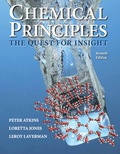
(a)
Interpretation:
The equilibrium constant at
Concept Introduction:
The equilibrium constant of a reaction can be calculated using the given expression,
(a)
Answer to Problem 5G.22E
The equilibrium constant of the given reaction is
Explanation of Solution
Given reaction is
The synthesis of trichloromethane (chloroform) from natural gas (methane):
Temperature of the reaction is
The
The
The
The
Here,
Now, the equilibrium constant of the reaction is calculated as
To calculate
Therefore, the
(b)
Interpretation:
The equilibrium constant at
Concept introduction:
Refer to part (a).
(b)
Answer to Problem 5G.22E
The equilibrium constant of the given reaction is.
Explanation of Solution
Given reaction is
The hydrogenation of acetylene to ethane:
Temperature of the reaction is
The
The
The
Here,
Now, the equilibrium constant of the reaction is calculated as
To calculate
Therefore, the
(c)
Interpretation:
The equilibrium constant at
Concept introduction:
Refer to part (a).
(c)
Answer to Problem 5G.22E
The equilibrium constant of the given reaction is
Explanation of Solution
Given reaction is
The final step in the industrial production of nitric acid:
Temperature of the reaction is
The
The
The
The
Here,
Now, the equilibrium constant of the reaction is calculated as
To calculate
Therefore, the
(d)
Interpretation:
The equilibrium constant at
Concept introduction:
Refer to part (a).
(d)
Answer to Problem 5G.22E
The equilibrium constant of the given reaction is
Explanation of Solution
Given reaction is
The reaction of hydrazine and oxygen in a rocket:
The
The
The
The
Temperature of the reaction is
Here,
Now, the equilibrium constant of the reaction is calculated as
To calculate
Therefore, the
Want to see more full solutions like this?
Chapter 5 Solutions
EBK CHEMICAL PRINCIPLES
- Actually, the carbon in CO2(g) is thermodynamically unstable with respect to the carbon in calcium carbonate(limestone). Verify this by determining the standardGibbs free energy change for the reaction of lime,CaO(s), with CO2(g) to make CaCO3(s).arrow_forwardCalculate the standard Gibbs free-energy change when SO3 forms from SO2 and O2 at 298 K. Why is sulfur trioxide an important substance to study? (Hint: What happens when it combines with water?)arrow_forwardAnother step in the metabolism of glucose, which occurs after the formation of glucose6-phosphate, is the conversion of fructose6-phosphate to fructose1,6-bisphosphate(bis meanstwo): Fructose6-phosphate(aq) + H2PO4(aq) fructose l,6-bisphosphate(aq) + H2O() + H+(aq) (a) This reaction has a Gibbs free energy change of +16.7 kJ/mol of fructose6-phosphate. Is it endergonic or exergonic? (b) Write the equation for the formation of 1 mol ADP fromATR for which rG = 30.5 kJ/mol. (c) Couple these two reactions to get an exergonic process;write its overall chemical equation, and calculate theGibbs free energy change.arrow_forward
- Determine the standard Gibbs free energy change, rG, for the reactions of liquid methanol, of CO(g), and ofethyne, C2H2(g), with oxygen gas to form gaseous carbondioxide and (if hydrogen is present) liquid water at298 K. Use your calculations to decide which of thesesubstances are kinetically stable and which are thermodynamically stable: CH3OH(), CO(g), C2H9(g), CO2(g),H2O().arrow_forwardDescribe a nonchemical system that is not in equilibrium, and explain why equilibrium has not been achieved.arrow_forwardConsider the reaction NH4+(aq) H+(aq)+NH3(aq) Use G f for NH3(aq) at 25C=26.7 kJ/mol and the appropriate tables to calculate (a) G at 25C (b) Ka at 25Carrow_forward
- The ionization constant, Ka, for acetic acid is 1.8 105 at 25 C. What is the value of rG for this reaction? Is this reaction product- or reactant-favored at equilibrium?arrow_forwardAdenosine triphosphate, ATP, is used as a free-energy source by biological cells. (See the essay on page 624.) ATP hydrolyzes in the presence of enzymes to give ADP: ATP(aq)+H2O(l)ADP(aq)+H2PO4(aq);G=30.5kJ/molat25C Consider a hypothetical biochemical reaction of molecule A to give molecule B: A(aq)B(aq);G=+15.0kJ/molat25C Calculate the ratio [B]/[A] at 25C at equilibrium. Now consider this reaction coupled to the reaction for the hydrolysis of ATP: A(aq)+ATP(aq)+H2O(l)B(aq)+ADP(aq)+H2PO4(aq) If a cell maintains a high ratio of ATP to ADP and H2PO4 by continuously making ATP, the conversion of A to B can be made highly spontaneous. A characteristic value of this ratio is [ATP][ADP][H2PO4]=500 Calculate the ratio [B][A] in this case and compare it with the uncoupled reaction. Compared with the uncoupled reaction, how much larger is this ratio when coupled to the hydrolysis of ATP?arrow_forwardThe equilibrium constant for a certain reaction increases by a factor of 6.67 when the temperature is increased from 300.0 K to 350.0 K. Calculate the standard change in enthalpy (H) for this reaction (assuming H is temperature-independent).arrow_forward
 ChemistryChemistryISBN:9781305957404Author:Steven S. Zumdahl, Susan A. Zumdahl, Donald J. DeCostePublisher:Cengage Learning
ChemistryChemistryISBN:9781305957404Author:Steven S. Zumdahl, Susan A. Zumdahl, Donald J. DeCostePublisher:Cengage Learning
 Chemistry: An Atoms First ApproachChemistryISBN:9781305079243Author:Steven S. Zumdahl, Susan A. ZumdahlPublisher:Cengage Learning
Chemistry: An Atoms First ApproachChemistryISBN:9781305079243Author:Steven S. Zumdahl, Susan A. ZumdahlPublisher:Cengage Learning Chemistry: The Molecular ScienceChemistryISBN:9781285199047Author:John W. Moore, Conrad L. StanitskiPublisher:Cengage Learning
Chemistry: The Molecular ScienceChemistryISBN:9781285199047Author:John W. Moore, Conrad L. StanitskiPublisher:Cengage Learning Chemistry: Principles and ReactionsChemistryISBN:9781305079373Author:William L. Masterton, Cecile N. HurleyPublisher:Cengage Learning
Chemistry: Principles and ReactionsChemistryISBN:9781305079373Author:William L. Masterton, Cecile N. HurleyPublisher:Cengage Learning General Chemistry - Standalone book (MindTap Cour...ChemistryISBN:9781305580343Author:Steven D. Gammon, Ebbing, Darrell Ebbing, Steven D., Darrell; Gammon, Darrell Ebbing; Steven D. Gammon, Darrell D.; Gammon, Ebbing; Steven D. Gammon; DarrellPublisher:Cengage Learning
General Chemistry - Standalone book (MindTap Cour...ChemistryISBN:9781305580343Author:Steven D. Gammon, Ebbing, Darrell Ebbing, Steven D., Darrell; Gammon, Darrell Ebbing; Steven D. Gammon, Darrell D.; Gammon, Ebbing; Steven D. Gammon; DarrellPublisher:Cengage Learning





